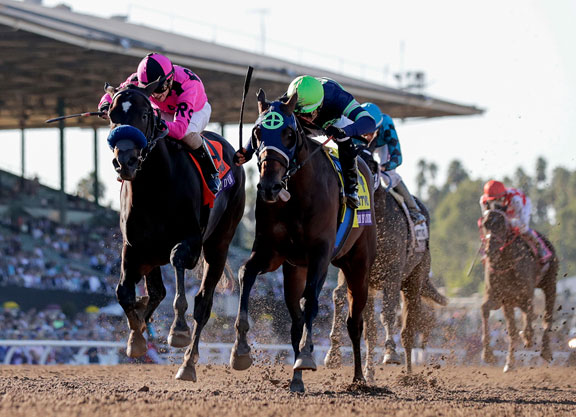By Chris McGrath
There's been some pretty faint praise for the winner of what generally proves the key race to determine the best 2-year-old colt of his crop. So much so, that plenty of Eclipse voters were plainly hoping that Tiz The Law (Constitution) could pull the championship rug from under the feet of Storm The Court (Court Vision), shock winner of the GI Breeders' Cup Juvenile, when odds-on for the GII Kentucky Jockey Club S. last Saturday.
In the event, Tiz The Law succumbed to the same stage fright that unravelled more fancied horses when Storm the Court emulated his sire, 64-1 winner of the Mile in 2011, as a hear-a-pin-drop Breeders' Cup winner. His defeat presumably restores Storm the Court to pole position, though the turf winners at the Breeders' Cup may yet enter the equation. But whoever ultimately gains the laurels, it must be pretty irritating for connections of Storm the Court to hear his success treated as an aberration, sooner credited to inconsistencies in track and opposition than to his own merit.
No doubt too many preconceptions are challenged by the possibility that the champion of his generation might be a colt who once changed hands for $5,000, out of a Tejano Run mare and by a sire who started in Ontario and now stands in Louisiana.
Sure enough, when Eight Rings (Empire Maker) collided with him in the GI Runhappy Del Mar Futurity S., and both lost their riders, Storm the Court was considered merely collateral damage. Eight Rings, a $520,000 yearling, proceeded to consolidate that assumption when leaving Storm the Court toiling into a distant third, albeit still green, on their next start. But if Eight Rings was a very different animal at the Breeders' Cup, then so too was the blinkered Storm the Court.
And if his page owes its only previous black-type to his granddam's sister, stakes-placed in Panama, then all the more reason for taking a look at the eligibility of his sire to pass on superior genes. Because actually there are very few stallions standing anywhere with a better combination of pedigree and competitive longevity than Court Vision.
Storm the Court is a product of his sire's single season in Kentucky, 2016, just after his first runners had hit the track in Canada. Unfortunately, Court Vision had already fallen victim to a change in the commercial landscape in Ontario, following the demise of slots at the track.
Spendthrift had put the son of Gulch in the best of hands, with Michael Byrne of Park Stud, who found him over 200 mares across his first two seasons. Court Vision also served time in Chile, but with the Ontario broodmare herd dwindling, Spendthrift resolved to relaunch him in Kentucky. At such a delicate stage of his career, however, he mustered a book of just 37 mares–including Storm the Court's dam My Tejana Storm, a three-time scorer who had produced a couple of hard-knocking winners by mediocre stallions–and was promptly moved on to Arcadiana Equine @ Copper Crowne.
His transfer to Louisiana yielded an initial spike in interest, as he entertained 86 and then 61 partners, but this spring he was down to 32. The question now is whether Storm the Court has emerged in time to reverse that trend.
The vagaries of breeding are such that we can never be surprised if any stallion comes up with one really good horse; nor if that single bright spark proves to be unrepeatable. But Court Vision had made a perfectly respectable start before circumstances conspired against him.
Of his intake, only Uncle Mo (from 150 named foals) and Twirling Candy (83) had more black-type horses from their first juveniles than did he (from 53). Court Vision's second crop included Canadian champion juvenile King and His Court and a slower-maturing type in Mr Havercamp, who has won eight of 14 starts, this summer adding the GIII Forbidden Apple S. at Saratoga to his fine achievements last year: two Grade II wins sandwiching his second to Oscar Performance (Kitten's Joy) in the GI Ricoh Woodbine Mile. (Not bad for a $19,000 yearling buyback.)
Clearly there will be limitations to the help he can now expect from Louisiana mares. But it would be very wholesome, from a neutral standpoint, if Storm the Court's obvious courage and commitment could qualify him for a role on the Triple Crown trail next spring. Because there's no denying that Court Vision offers regional breeders a cut-price package (at $3,500) of heritable virtues matched by few Kentucky stallions.
First, the performance: a smart juvenile on dirt (taking each step in his stride: maiden, GIII Iroquois S., GII Remsen S.) who won at least one Grade I prize on turf in each of the next FOUR seasons, for a career tally of nine wins in 31 starts. In his final bow he denied the great Goldikova (Ire) (Anabaa) her fourth Breeders' Cup Mile, taking his earnings to $3.75 million.
And second, the pedigree: his dam Weekend Storm was an unraced sister to GI Preakness S. winner Summer Squall (Storm Bird), and so also a half-sister to the breed-shaping A.P. Indy. She is the best producing daughter of their great dam Weekend Surprise: her 11 winners include, not just Court Vision, but also his full-brother Kipling, sire of another Breeders' Cup Mile winner in Kip Deville, plus a handful of other stakes winners/performers.
While this is obviously one of the best-known families in the book, extending to Missy Baba, it's worth just reiterating how flawless is the sequence of broodmare sires seeding Court Vision's bottom line: Storm Bird, Secretariat, Buckpasser, Sir Gaylord (the second and fourth, of course, half-brothers). As such, regardless of whether Storm the Court can give him a renewed vogue, it would be no surprise to see Court Vision's daughters become good producers in time.
After all, his aristocratic maternal line gets wonderful balance from the old-fashioned grit and industry we associate with his sire Gulch–whose dam Jameela only produced one other foal before she was killed by lightning.
Jameela had a remarkable career, winning 27 of her 58 starts (Ladies H., Delaware H. etc). She was by Rambunctious out of a Seven Corners mare and, while those names might not ring too many bells nowadays, both extended vital European lines (as conduits for Hyperion and Sir Gallahad, respectively). Combined with several European strands in the background of his sire Mr. Prospector, perhaps these contributed to dirt champion Gulch's lopsided record as a turf influence at stud.
By modern standards, at any rate, Jameela evidently passed on the toughness of her family (her second dam won 18 of 96 starts; her third dam, 13 of 118): Gulch won 13 of 32 starts and his less-distinguished brother, five of 41. Gulch's Grade I haul, remember, extended through the Hopeful and Futurity at two, the Met and Wood Memorial at three, and the Breeders' Cup Sprint, Met and Carter H. at four.
The Mr. P. speed that made Gulch champion sprinter in that last campaign was quickly parlayed–between Mr. P.'s versatility as an influence, on the one hand, and the type of Jameela soundness Mr. P. sometimes requires, on the other-into a Derby and Belmont success for Thunder Gulch. Gulch's best European son, Nayef, was also top-class over Classic distances.
Gulch's line is looking quite precarious, but Nayef sired an excellent stallion, for his fee bracket, in Tamayuz. And Storm the Court, with the street-fighting toughness required for the Derby trail, could someday do his bit for his own sire's branch. But Court Vision himself is still only 14, so let's see whether his first Louisiana books can sustain a new lease of life.
After all, if Eclipse voters have sought elsewhere for a solution before settling on Storm the Court, then breeders seeking a bargain may find themselves doing much the same with his sire.
Not a subscriber? Click here to sign up for the daily PDF or alerts.






